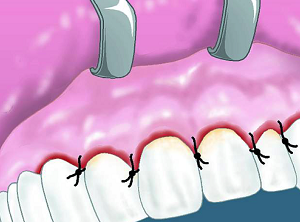 Many people are worried about various problems with their teeth. One of them is the abnormal size of the gums, which leads either to excessive denudation of the roots of the teeth, or vice versa, to the influx of excess periodontal tissue on the teeth.
Many people are worried about various problems with their teeth. One of them is the abnormal size of the gums, which leads either to excessive denudation of the roots of the teeth, or vice versa, to the influx of excess periodontal tissue on the teeth.
This not only spoils the aesthetic appearance of the human oral cavity, but also causes various kinds of trouble, for example, increased sensitivity of the teeth. If it was virtually impossible to remedy the situation recently, today modern technologies allow this.
For the purpose of correcting the size and shape of gum tissues directly in contact with the teeth, a special patchwork operation called gingivoplasty is performed. Today, this is a very common and popular procedure, which is used to restore the normal condition of periodontal disease.
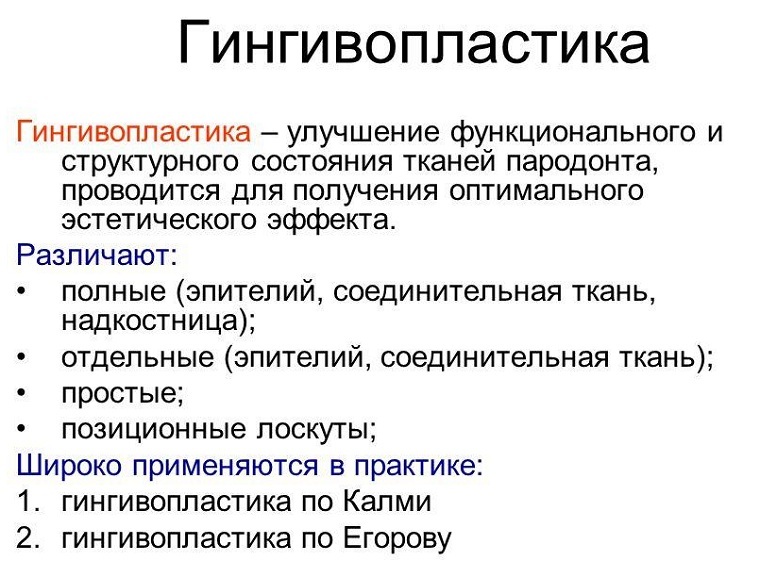
Contents of
- Why and who needs it?
- Limitations and contraindications
- Preoperative preparation
- How is operation
- Rehabilitation period
- Possible consequences
- Price of issue
Why and to whom is it needed?
The specialists of periodontists can recommend gingivoplasty in different cases. Most often, this method is used to solve the following problems:
- aligning the position of the gum relative to the entire row of teeth, because it often happens that different teeth are covered with a gum at different levels;
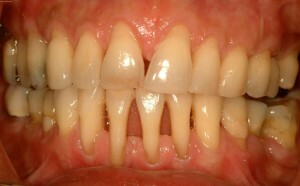
- for tissue correction for periodontal disease, gingivitis and periodontitis;
- in case of excessive growth of gum tissue on the teeth, which greatly spoils the appearance of a person;
- in case the gum is, on the contrary, too high and even bare the root part of the tooth, which is manifested by excessive tooth sensitivity and a number of other problems;
- to restore the normal state of the so-called periodontal pockets - the formed space between the tooth and gum due to the destruction of the normal connection between them;
- solely for cosmetic effect, to make a person smile more beautiful and pleasant.
These are the main cases when a doctor can recommend gum plastic surgery.
Limitations and contraindications
Regarding the question of who should be avoided, permanently or temporarily, this situation should be noted:
- presence of respiratory diseases;
- problems with normal blood coagulability;
- oncological diseases;
- diabetes mellitus;
- plastic can not be carried to people who are currently unacceptable with the introduction of anesthesia;
- procedure is contraindicated in cases of chronic alcoholism, as well as the presence of bone diseases.
Do not take gum correction as an easy operation. This is quite a serious and responsible exercise, so he has these contraindications, which can strongly affect the outcome, if not pay attention to them.
Preoperative preparation
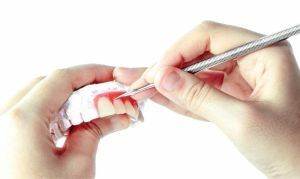 In order for everything to be as successful as possible and without any unexpected negative consequences, some preparatory measures are required before the operation. There are quite a few of them, nevertheless, one can not ignore such provisions. So, the result of periodontal plastic surgery will be more predictable if the following preparatory steps are taken before surgical intervention:
In order for everything to be as successful as possible and without any unexpected negative consequences, some preparatory measures are required before the operation. There are quite a few of them, nevertheless, one can not ignore such provisions. So, the result of periodontal plastic surgery will be more predictable if the following preparatory steps are taken before surgical intervention:
- before the procedure, the doctor must take necessary measures to prevent entering into the operated area of any extraneous infections and other negative elements: pigmentation, tartar, plaque andother;
- measures should be taken to reduce inflammation of the gums after surgery;
- it is important to take measures to reduce bleeding, for this 2-3 days before surgery can be prescribed funds that narrow the blood vessels;
- , the probing of periodontal pockets and local topography should be performed before the operation itself.
By adhering to these rules, the doctor significantly increases the chances of successfully carrying out operational activities and minimizing the consequences of such intervention.
How the operation is performed
The periodontal tissue is plasticized in several stages:
- The first thing the doctor does is inject the patient with local anesthesia. With this method of analgesia, the person is
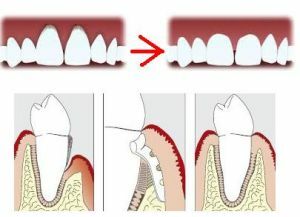 completely conscious, but does not feel anything, since the anesthetic blocks the work of the nerve endings.
completely conscious, but does not feel anything, since the anesthetic blocks the work of the nerve endings. - The place where it is planned to make incisions on the gums is treated very qualitatively with antibacterial agents. It is necessary to achieve complete sterility so that infections and harmful bacteria do not enter the blood, into the wound.
- Further gum incisions are made, the tooth under them is slightly opened and cleared of caries, plaque, the size of the overhanging tissue is adjusted.
- A graft of a gum of already corrected size is returned to its place and fixed with the help of special microshives.
This is a typical sequence of actions, but in each specific case, changes in the procedure can be made and any additional measures applied.
Review of a patient who recently underwent gingivoplasty:
I always had not very beautiful teeth and all because of the very strong gums on them. I learned that the periodontal tissue can be corrected and decided to take a chance.
I found a very good doctor, consulted and agreed to an operation. Everything went pretty quickly and painlessly. Teeth immediately began to look much better. I was very pleased and I do not regret that I decided to take such a step.
Maria, 18 years old. G. Moscow
Rehabilitation period
For healing to occur quickly and without any serious problems and deviations, it is necessary to adhere to certain rules and security measures.
First of all, you should pay attention to the food you eat: it should not be too hard or very salty. Food during this period is selected moderately warm, soft, not filled with a variety of spicy seasonings and sauces. Also, the food should not be too acidic or salty.
For a couple of weeks after the operation, it is strictly recommended not to brush your teeth. This procedure should be replaced with rinses of the oral cavity with the help of special antibacterial agents.
It is also desirable to exclude for some time excessive physical exertion, for example, boxing, weightlifting or swimming. After all, if a fist gets into the operated gum section in the boxing section, it obviously will not do.
Also important is the complete rejection of cigarettes and alcohol. Nicotine and alcohol can cause discomfort in the gum tissue and damage the stitches applied to them.
The result is worth the pain of the recovery period - a photo of the patient before and after the gingivoplasty:

Possible consequences of
Usually in most patients everything goes well and without any problems. But it is quite natural that after surgery, some unpleasant temporary events can occur:
- slight loosening of teeth in the area of the incisions;
- swelling of the gingival tissue, but as a rule, they go off a couple of days after the operation;
- is often observed increased sensitivity of the teeth, as well as pain in the gums, it is usually not so strong, but if necessary, it can be damped by an anesthetic.
On this typical list of consequences ends.
Question price
The cost of the procedure may vary depending on the level of the specialist performing it, the price policy of the clinic, the materials used during the operation, and the quality and quantity of additional services.
Usually the price of gingivoplasty is rather small and lies in the range of several hundred to several thousand rubles( 500 - 10,000 on average), which depends a lot on the level of complexity of the problem.
